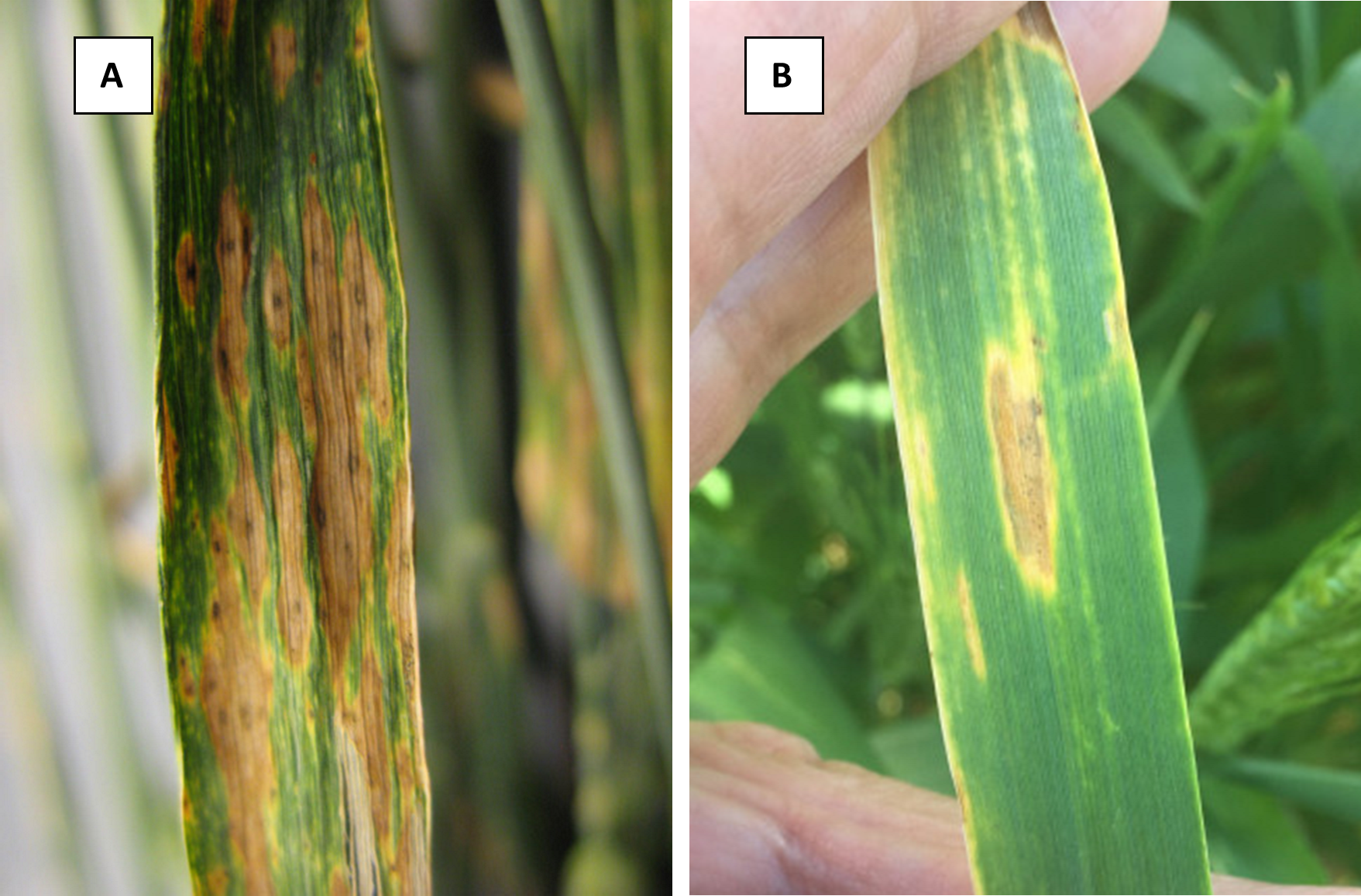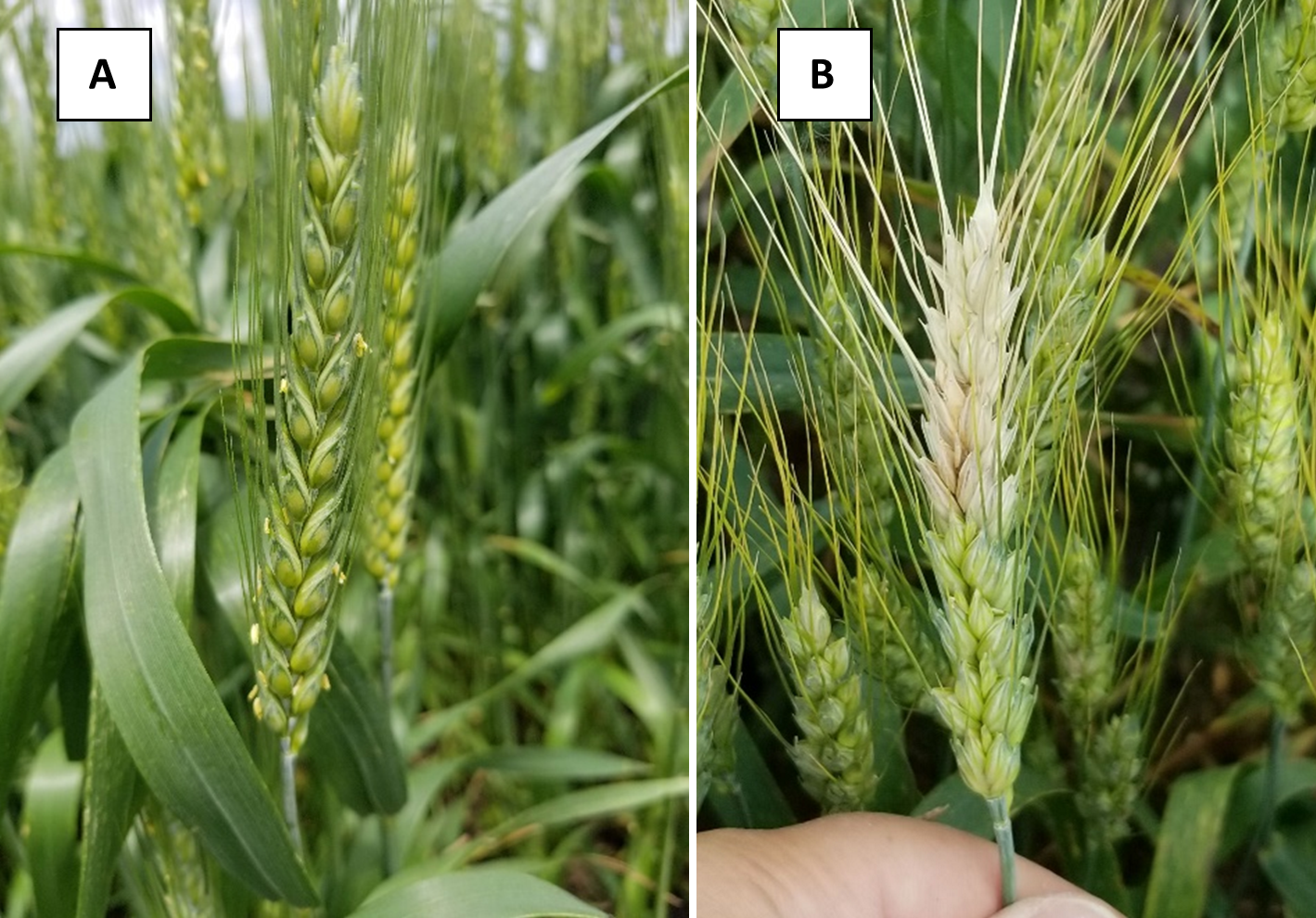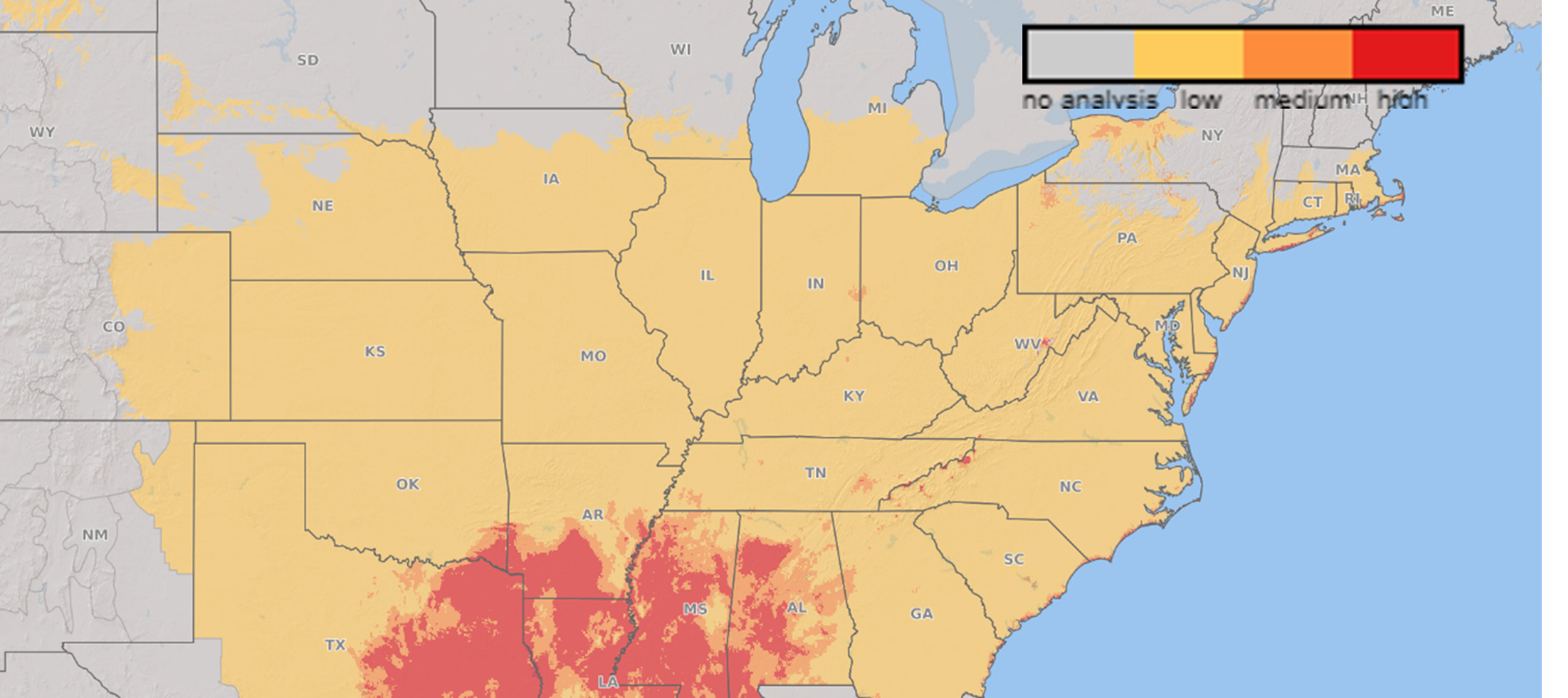It is time to keep an eye on wheat for diseases and scab risk. There are a number of foliar diseases in wheat to watch out for. These include – leaf, strip and stem (Fig. 1A,B,C), Septoria leaf spot and tan spot (Fig. 2A,B). A number of resources are available to help distinguish wheat leaf diseases and “Identifying Rust Diseases of Wheat and Barley.” https://www.ars.usda.gov/ARSUserFiles/50620500/Cerealrusts/Rust_Diseases_National.pdf
Samples can always be submitted to the Purdue Plant Pest Diagnostic Lab for disease identification and confirmation.

Figure 1. Pustules of leaf rust (A), strip rust (B) and stem rust (C) in wheat. Image source. A) A. Friskop at https://cropprotectionnetwork.org/encyclopedia/leaf-rust-of-wheat, B). C. Grau at https://cropprotectionnetwork.org/encyclopedia/stripe-rust-of-wheat and D. Telenko, Purdue University.

Figure 2. A) Elliptical, tan-brown lesions of Septoria tritici blotch, and 2) tan spot leaf lesion on wheat. Image source: M. Burrows https://cropprotectionnetwork.org/encyclopedia/septoria-tritici-blotch-of-wheat and https://cropprotectionnetwork.org/encyclopedia/tan-spot-of-wheat
Wheat in Indiana is between 6-10 feekes at the end of last week and some of our southern fields are at boot stage (Feekes 10). Therefore, I expect flowering to start over the next couple of weeks (Fig 3A). During flowering (anthesis) warm, wet weather with high relative humidity will favor the development of Fusarium head blight (scab). Fusarium head blight (FHB) is caused by the fungus Fusarium graminearium. It infects wheat during flowering, beginning at Feekes 10.5.1. Symptoms of FHB will appear as bleaches spiklets on the head later in the season (Fig 3B). Infection can lead to small or shriveled grain kernels referred to as “tombstones.” In addition to shriveled grain this fungus produces mycotoxins such as deoxynivalenol (DON), which can accumulate in the infected grain.

Figure 3. A) Wheat beginning to flower and B) Fusarium head blight infection. (Photo credit: Darcy Telenko)
A number of resources are available to help you make disease management decisions in wheat.
1) The Fusarium Risk Assessment Tool is available at the following website. http://www.wheatscab.psu.edu/. This tool estimates the risk of a Fusarium head blight epidemic (> than 10% field severity) using weather conditions (temperature, rainfall, and relative humidity) measured 15 days prior to flowering. See below for the current risk map – much of Indiana is colored yellow (medium risk for scab development) and red (high risk for scab development) due to recent wet weather.
Keep in mind that actual disease risk depends heavily on the growth stage of wheat in your area. We are still on the early side; the estimate is most relevant just prior to flowering (Feekes 10.5.1) or the early stages of grain development. Fusarium head blight risk is highest when there are three or more days with extended periods of high relative humidity and moderate temperatures (65 to 80°F) during the early stages of kernel development. See below for the current risk map – much of Indiana is colored yellow (medium risk for scab development) and red (high risk for scab development) due to recent wet weather (Fig. 4).

Figure 4. Fusarium Risk Assessment Tool Indiana map generated on 22 May 2024. Red = high risk, Orange = medium risk, and Yellow = low risk for Fusarium head blight on wheat just prior to flowering or the early stages of grain development. Image credit: http://www.wheatscab.psu.edu/.
Farmers and crop advisors can sign up for alerts from the U.S. Wheat and Barley Scab Initiative, these can be sent to a cell phone as a text or email. To sign up visit https://scabusa.org/scripts/FHB_Alerts/
2) Fungicide Application: A fungicide application might be considered if a Fusarium head blight (FHB) susceptible variety is planted, or if you are worried about scab on your farm. These applications should be made at Feekes 10.5.1, or early flowering to suppress FHB. Fungicides recommended for FHB and DON include Prosaro, Caramba, Proline, and Miravis Ace. The use of products containing strobilurin fungicides may result in higher levels of DON accumulation in grain when damaged by FHB. These are not labelled for FHB management.
Fungicide Efficacy Tables are updated yearly and available from the Crop Protection Network
- Fungicide Efficacy for Control of Wheat Diseases CPN -3002 (https://cropprotectionnetwork.org/publications/fungicide-efficacy-for-control-of-wheat-diseases)
- Optimizing Fungicide Use for Fusarium Head Blight (Scab) and Associated Mycotoxins CPN-3001 are two available resources (https://cropprotectionnetwork.org/publications/optimizing-fungicide-use-for-fusarium-head-blight-scab-and-associated-mycotoxins).
These tables can help you identify products to use based on your targeted disease. As a reminder follow the label on harvest restriction as some products may have 30 to 45 days required between last fungicide application and harvest.
Luckily, most of our wheat is still a few weeks from flower, but this should be a warning to keep an eye on your fields. Those most at-risk would-be fields that were planted to a Fusarium head blight susceptible variety or those with limited rotation that follow a previous crop of wheat or corn.


